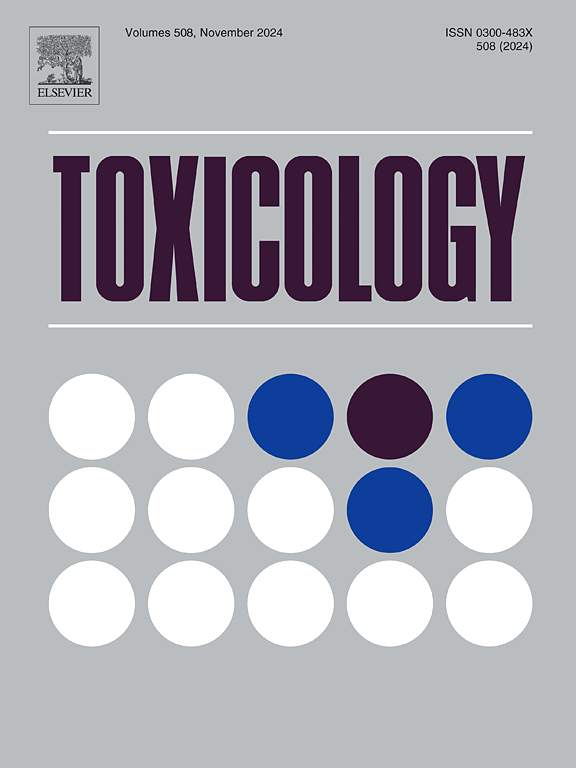Effects of two typical organophosphate flame retardants on DNA damage of GT1–7 cells and relevant molecular mechanism
IF 4.8
3区 医学
Q1 PHARMACOLOGY & PHARMACY
引用次数: 0
Abstract
The tris (2-chloroethyl) phosphate (TCEP) and tri-n-butyl phosphate (TNBP) are two typical organophosphate esters (OPEs), which have estrogenic activity. However, fewer studies have been conducted on their genotoxicity and mechanisms. In this study, we evaluated the effects of TCEP and TNBP on cellular DNA damage in GT1–7 cells and examined the role of estrogen signaling in regulating DNA damage. The results showed that TCEP and TNBP significantly inhibited the cell viability and elevated intracellular reactive oxygen species (ROS) levels at higher exposure concentrations. TCEP and TNBP at test concentrations significantly increased comet tail length, comet tail DNA percentage (Tail DNA%), and Olive tail moment (OTM) values, indicating that TCEP and TNBP induced cellular DNA damage. In addition, TCEP and TNBP significantly upregulated the mRNA levels of target genes related to DNA damage-repair pathways, and elevated the expression of ataxia-telangiectasia mutated (ATM) and γ-H2AX proteins associated with DNA double-strand breaks. Furthermore, TCEP and TNBP significantly up-regulated the expression of membrane bound G-protein coupled estrogen receptor 1 (GPER) protein and increased the phosphorylation of extracellular signal-regulated kinases 1/2 (ERK1/2) at 10 µM. While the pretreatment of GPER1 inhibitor G15 and ERK1/2 inhibitor U0126 significantly inhibited the up-regulation of mRNA expression of the target genes associated with the DNA damage-repair pathways and decreased the DNA damage induced by TCEP and TNBP. These findings indicate that TCEP and TNBP activate GPER1/ERK1/2 signaling pathway which plays an important role in regulating DNA damage. The study will provide a novel insight into the genotoxicity mechanism of OPEs.
两种典型有机磷阻燃剂对GT1-7细胞DNA损伤的影响及其分子机制
三(2-氯乙基)磷酸(TCEP)和三-正丁基磷酸(TNBP)是两种具有雌激素活性的典型有机磷酸酯(OPEs)。然而,对其遗传毒性和机制的研究较少。在本研究中,我们评估了TCEP和TNBP对GT1-7细胞DNA损伤的影响,并研究了雌激素信号在调节DNA损伤中的作用。结果表明,TCEP和TNBP在高暴露浓度下显著抑制细胞活力,提高细胞内活性氧(ROS)水平。试验浓度下TCEP和TNBP显著增加了彗尾长度、彗尾DNA百分比(tail DNA%)和橄榄尾矩(Olive tail moment, OTM)值,表明TCEP和TNBP诱导了细胞DNA损伤。此外,TCEP和TNBP显著上调DNA损伤修复通路相关靶基因mRNA水平,上调与DNA双链断裂相关的ataxa -毛细血管扩张突变(ATM)和γ-H2AX蛋白的表达。此外,TCEP和TNBP显著上调了膜结合g蛋白偶联雌激素受体1 (GPER)蛋白的表达,并增加了10 µM时细胞外信号调节激酶1/2 (ERK1/2)的磷酸化。而预处理GPER1抑制剂G15和ERK1/2抑制剂U0126可显著抑制DNA损伤修复通路相关靶基因mRNA表达上调,降低TCEP和TNBP诱导的DNA损伤。这些结果表明,TCEP和TNBP激活GPER1/ERK1/2信号通路,在调控DNA损伤中发挥重要作用。该研究将为OPEs的遗传毒性机制提供新的见解。
本文章由计算机程序翻译,如有差异,请以英文原文为准。
求助全文
约1分钟内获得全文
求助全文
来源期刊

Toxicology
医学-毒理学
CiteScore
7.80
自引率
4.40%
发文量
222
审稿时长
23 days
期刊介绍:
Toxicology is an international, peer-reviewed journal that publishes only the highest quality original scientific research and critical reviews describing hypothesis-based investigations into mechanisms of toxicity associated with exposures to xenobiotic chemicals, particularly as it relates to human health. In this respect "mechanisms" is defined on both the macro (e.g. physiological, biological, kinetic, species, sex, etc.) and molecular (genomic, transcriptomic, metabolic, etc.) scale. Emphasis is placed on findings that identify novel hazards and that can be extrapolated to exposures and mechanisms that are relevant to estimating human risk. Toxicology also publishes brief communications, personal commentaries and opinion articles, as well as concise expert reviews on contemporary topics. All research and review articles published in Toxicology are subject to rigorous peer review. Authors are asked to contact the Editor-in-Chief prior to submitting review articles or commentaries for consideration for publication in Toxicology.
 求助内容:
求助内容: 应助结果提醒方式:
应助结果提醒方式:


